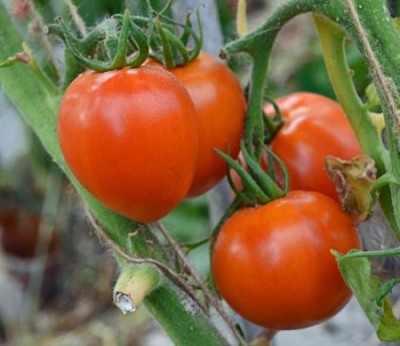
- Authors: Myazina L.A.
- Year of approval: 2007
- Category: grade
- Growth type: indeterminate
- Appointment: fresh consumption, for pickling and preserving, for juice
- Ripening period: mid-season
- Ripening time, days: 100-105
- Growing conditions: for open ground, for film greenhouses
- Bush size: tall
- Bush height, cm: up to 150 cm
Along with the proven and beloved tomatoes that are grown in gardens and personal plots, every summer resident dreams of growing large tomatoes with excellent taste. Among the large-fruited varieties, one of the most popular is the tomato Smoothie, which also grows in beds, in film greenhouses.
Breeding history
This mid-season variety Smoothie is the result of the fruitful work of a group of Russian breeders headed by L.A. Myazina. The tomato was created in 2001, and joined the ranks of the State Register of Breeding Achievements of the Russian Federation in 2007. The variety is recommended for cultivation in all climatic zones of the country.
Description of the variety
Tomatoes Smoothie is a tall plant of an indeterminate type that can grow up to 150 cm. The bush is characterized by a weak thickening of dark green leaves, a powerful central stem and flexible branches with a noticeable edge, a developed root system and an intermediate type of inflorescence. The first fruit cluster appears above the 6th leaf. Up to 3-5 berries are formed in each fruit cluster.
During planting and growing crops, do not forget about the mandatory formation of 2-3 stems, partial removal of the stepsons and tying the stems and branches to strong supports, since weighty tomatoes can deform and break the bush.
The main qualities of the fruit
Tomato Smoothie is a tasty and bright representative of the class of large-fruited tomatoes. On average, the weight of the berry reaches 160-175 grams, but in greenhouses the fruits are much larger - 300-350 g. The color of the vegetable is uniform, rich red, and in an unripe form it is light green. The shape of the tomato is heart-shaped, with slight ribbing, but sometimes a slight flattening is traced. The skin of tomatoes is shiny and thin, not prone to cracking.
In addition, the fruits tolerate transportation well and can be stored for a long time under the right conditions. The purpose of the vegetable is salad, but it is suitable for canning and processing.
Taste characteristics
The taste of giant tomatoes is excellent. The flesh of the vegetable is moderately firm, fleshy and very juicy. The advantage of the variety is the composition of the tomato, thanks to which the vegetable is ideal for dietary nutrition. The taste is dominated by sweetness and sugariness, complemented by a strong tomato aroma, which is felt as soon as the tomato is cut. There are few seeds in the pulp, white veins and voids are not observed.
Ripening and fruiting
The variety is mid-season. From the moment of full germination of seeds to the ripening of the first berries on the bushes, it takes 3-3.5 months (100-105 days). Fruiting in the culture is extended, so for a long period you can feast on ripe tomatoes from the garden. The first ripe tomatoes can be tasted in the middle of summer. The phase of active ripening of berries occurs at the end of July - September. The most recent tomatoes are harvested green and ripen well at room temperature.
Yield
The yield of this variety is average. When all agrotechnical recommendations are fulfilled, 2.5-3.5 kg of vegetables are removed from 1 bush per season. In the greenhouse, the yield is 20-25% higher. According to experienced farmers, it is possible to slightly increase the yield by pinching the top of the bush 2 weeks before the end of the growing season.
The timing of planting seedlings and planting in the ground
The cultivation of a vegetable is carried out exclusively in a seedling way. Sowing seeds is carried out in late March - early April. Good germination of seedlings occurs at a room temperature of + 20 ... 25 degrees and sufficient lighting. At the stage of formation of 2 real leaves on the bushes, you can dive them in separate cups.
Transplantation of seedlings into open ground is carried out at the age of 55-60 days. At this point, the bush should have 6-7 leaves and one fruit cluster. It is recommended to transplant seedlings in May, when the air and ground are well warmed up. As a rule, the air should be warmed up to + 15 ... 17 degrees.

Growing tomato seedlings is an extremely important process, because it largely depends on whether the gardener will be able to harvest at all. All aspects must be taken into account, from seedbed preparation to planting in the ground.
Landing scheme
Planting density and pattern are very important when growing nightshade crops. For 1 m2, it is enough to arrange 3 bushes, which will provide air and light to the plants. The optimal layout for planting is 40x70 cm.

Growing and care
Tomatoes grow well in loose, fertile and breathable soil. In addition, the soil should be well fed with fertilizers, since tomatoes respond positively to fertilizing. A special variety does not require care, but it needs standard agricultural technology - watering, fertilizing, loosening the soil, forming and tying seedlings, pinching, protection from viruses and pests.




A plant needs different micronutrients at each stage of growth. All fertilizers can be divided into two groups: mineral and organic. Folk remedies are often used: iodine, yeast, bird droppings, eggshells.
It is important to observe the rate and period of feeding. This also applies to folk remedies and organic fertilizers.
Disease and pest resistance
High immunity is able to protect the tomato from top and root rot, tobacco mosaic virus and phytophthora. Spraying protects from insects.


Resistant to adverse weather conditions
The variety has excellent resistance to stress, so tomatoes are not afraid of drought, heat, temperature drops and even light frosts.

























































































